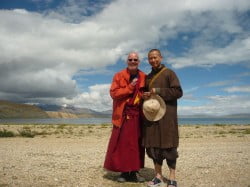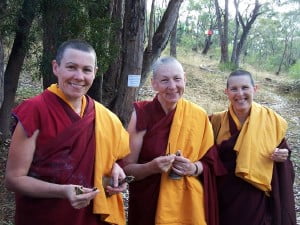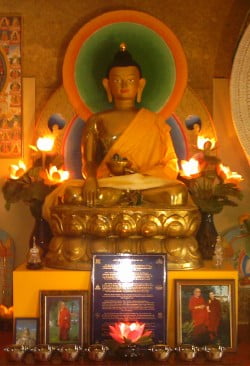There is an emphasis on building trust and support so that the Sangha are confident enough to share both the positive and negative things in their lives, which in turn leads to closer relationships with the people around and a flowering of love and compassion.
Plum Village: An International Monastic Community
By Ven. Thubten Kundrol
Plum Village is monastic community founded by the Ven. Thich Nhat Hanh who comes from a Vietnamese lineage. It is in central France and is open to all Buddhist practitioners and interested others.
The sound of singing was filling the air as I made my way to the dining hall my first afternoon at Plum Village. It was time for work meditation and it sounded as if the workers were very happy. Opening the door I found a large ring of nuns and a few lay people heartily singing from song sheets, two or three songs about the joys of life and the beauty of nature. They looked to be very happy as they were each given work by the work co-ordinator nun. In fact, the only unhappy person seemed to be me as I worried that cutting grass with an implement closely resembling kitchen scissors would increase the tendency to arthritis in my fingers.
As time went by I became more and more interested in how it was that 30 nuns and half-a-dozen laywomen were able to exist in quite cramped conditions, living three to a room, and still appear relaxed and unharrassed. During my two and a half weeks on the New Hamlet site, one of three sites making up Plum Village which started in 1982, I didn’t hear any harsh speech or witness any scenes of irritation and bad-temper. Certainly there were one or two nuns who seemed rather up and down but they did not appear to affect the positive energy of the group.
Talking to the nuns about this, I discovered that Thay, as Thich Nhat Hanh is called (Thay means teacher), has thought very carefully about the Sangha and how to create an environment with the conditions that will allow the Sangha to flourish. Particularly Thay emphasizes the practice of mindfulness and the feeling of family and there are many communal activities to support this and to create a nourishing atmosphere.
To begin with, Thay ordains nuns and monks with the condition that they will live within the monastic community. They are not allowed to continue their careers or to live at home. So from the start the Sangha understand this is how they will live and believe in the benefits of community living.
Each of the three hamlets has a daily schedule which the Sangha are expected to follow. At New Hamlet the day begins at 5.30am with one and a half hours of silent meditation, walking meditation, and chanting in the Buddha Hall. After breakfast in silence there is a study period. The nuns have language classes in French, English, Vietnamese, or classical Chinese. They also study the Vinaya. Before lunch there is a one-hour walking meditation for the community, usually outside, walking around the land amongst the many plum trees which give the centre its name. Most of the afternoon is taken up with work meditation and the day finishes with another session in the Buddha Hall.
This is the daily routine of the nuns. They are also divided into work families and take it in turns to do special jobs, e.g. cooking. Also nuns are assigned to different departments and have specific responsibilities: office, guest department, etc.
There are two mindfulness days a week. On these days the whole community comes together on one of the sites for a teaching by Thay who then leads walking meditation. In the afternoons are dharma discussions. One day a week is ‘lazy day’. On this day there is no schedule and the nuns and monks relax, do their own practice, study, and the like.
During the spring and summer four public retreats are held and the schedule completely changes. Retreats take place between April and August and last between one and six weeks. In August and September Thay has a teaching programme in North America and takes many of the nuns and monks with him. The ones remaining have responsibility for picking the ripened plums and making jam. For three months during the winter the Sangha are in retreat, meditating and receiving teachings from Thay. This is an outline of the daily and yearly routine, subject to change of course!
Having a clear routine and running dharma courses gives stability and a sense of purpose to the Sangha. At the same time the Sangha are empowered by having the responsibility for many community decisions and various councils are set up for this purpose with representatives from both the fully ordained Sangha and the novices.
The Sangha are highly regarded by Thay and he makes it very clear that without them Plum Village would not function. In fact, the Sangha are Plum Village.

All the work of organising and co-ordinating the courses and retreats is done by the Sangha. While I was in Plum Village the French retreat took place. Six hundred people came to stay and to listen to Thay teach on the Cittamatrin view. Each morning, before the teaching, around 80 nuns and monks stood in front of the audience and chanted prayers and sutras for fifteen minutes. Later they would lead dharma discussions and do all the mundane jobs required to keep a monastery and dharma centre running.
The lay community very much appreciates the monastics and the work done by them. They hear Thay praising the Sangha in his talks and are encouraged to go to any of the sisters and brothers, as they are called, any time they need help or advice. Thay stresses how important the Sangha are for the propagation of the Dharma and as a result there is no question about their high status. This is reflected in the self-confidence of the Sangha and I certainly did not feel that it encouraged them to be proud; more likely it encourages them to live up to Thay’s praise.
They are helped in this by a number of practices designed by Thay to help both the Sangha and the lay people live together peacefully and harmoniously.
One of these is the Beginning Anew ceremony which takes place in each hamlet once a fortnight. This is basically a recitation of one’s failings and an avowal to practise more diligently. It alternates with community meetings where the nuns share their feelings about recent events and encounters. Nuns use the meeting to express both positive and negative feelings, admissions of regret, explanations of where they’re coming from, and requests for the community’s help, patience, and tolerance etc. This openness about thoughts and feelings is a remarkable feature of life at Plum Village, something that has been validated and legitimised by being built into the community structure. At the same time people are encouraged to take responsibility for their problems and difficulties.
When two people are experiencing a lot of conflict, maybe a lot of anger, there is a technique called a Peace Treaty. The Treaty is a one-page document which itemizes specific behaviours to be followed by the people concerned and is signed by them. It enables the nuns or whomever to go away and think constructively. The two people concerned will arrange a date for a meeting to discuss the situation and may invite a third person to be present. In this way negative situations get sorted out and suppression and denial of the problem are avoided.
A technique encouraging members of the community to care for each other is called the Second Body practice. The first body is the nun’s own body. The second body is a person the nun has responsibility for. She pays attention to her second body, keeps an eye on her, notices if she is unhappy or sick, and does her best to be helpful and supportive. In turn, this nun who is called the caring friend, will be the second body of another nun. In this way each nun is responsible for someone else and also has someone to go to if she needs help. To help with the practice of equanimity second bodies rotate 2 or 3 times a year. Each nun also has a more senior nun as a spiritual mentor with whom she discusses her spiritual practice. There is also a mindfulness mentor who is responsible for discipline.
Before and after the winter retreat and occasionally at other times is an event called Shining Light. The nuns sit together and each nun is commented on in turn by the others. The comments are written down and given to the nun in question. It sounds rather threatening but this is a group of people who live closely together and who have learnt to trust and support one another. And to help the nuns not to dwell on each other’s faults, before even a slightly critical comment is made, two positive qualities of the nun in question must be mentioned. In this way the nuns are encouraged to see the good qualities of their sister nuns. When the retreat is over, the process is repeated, each nun receiving feedback on her efforts to transform.
Occasionally the nuns have a Tea Ceremony. One nun, often one who might be a little shy or lacking in confidence, is designated Tea Master and is responsible for making and pouring the tea. This is a time when the nuns come together to share in a social activity. It is a time for positive speech and nuns might mention something they’ve rejoiced over, share something that’s made them sad, recite a poem, sing a song, tell a story.
All these techniques have been set up by Thay to help the Sangha develop into a loving and supportive community. There is an emphasis on building trust and support so that the Sangha are confident enough to share both the positive and negative things in their lives, which in turn leads to closer relationships with the people around and a flowering of love and compassion. There is an emphasis on self-nourishment and being gentle, both with oneself and others, and I particularly noticed how pleasant the Sangha are to each other.
Of course Plum Village is not perfect and monks and nuns do disrobe but I think it is a very good example of how, with the appropriate guidance, people can live together in a supportive and harmonious way. The keys words however are ‘with appropriate guidance.’



